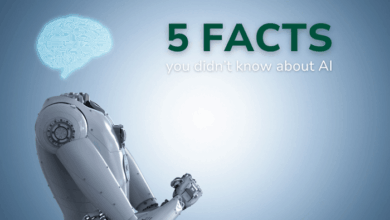
Why students using AI avoid learning is a pressing issue. Students are increasingly turning to AI tools for academic tasks, but this often leads to a disconnect from the very essence of learning. This article delves into the reasons behind this trend, exploring the perceived ease of AI tools, the impact on critical thinking skills, and the motivational factors at play.
We’ll also examine how AI use can affect learning outcomes and the role of societal and pedagogical influences in this evolving educational landscape.
The perceived simplicity of AI tools can quickly become a disincentive for deeper learning. Students might rely on AI for answers rather than engaging with the underlying concepts. This reliance can hinder the development of critical thinking skills, which are essential for success in today’s world. Furthermore, AI’s accessibility can impact motivation and engagement, potentially leading to a superficial understanding of complex subjects.
Perceived Ease of AI Tools

The allure of AI tools for students often lies in their perceived ease of use. Students, accustomed to instant gratification and streamlined solutions, might view AI as a shortcut to academic success. This perceived simplicity, however, can be a double-edged sword, potentially hindering genuine learning and critical thinking skills.AI tools, while capable of generating impressive outputs, often lack the depth of understanding and critical analysis that traditional learning methods cultivate.
This superficial engagement can lead to a reliance on AI, ultimately diminishing the student’s capacity for independent learning and problem-solving. The readily available nature of AI-powered solutions can significantly impact the perceived effort required for academic tasks. The immediate answers provided by AI might mask the complexities and nuance inherent in the subject matter.
Reasons for Perceived Ease
Students frequently perceive AI tools as easier due to their automated nature. The ability to quickly generate text, summaries, or even code can seem significantly faster and less demanding than the time-consuming process of research, synthesis, and writing involved in traditional methods. This immediate gratification can be highly motivating, but it often masks the underlying cognitive processes required for genuine understanding.
Students might be more drawn to the apparent simplicity than the effort needed to develop deeper learning skills.
Impact on Motivation for Deeper Learning
The ease with which AI tools produce results can demotivate students from engaging in deeper learning. The readily available answers might diminish the desire to explore the subject matter thoroughly, hindering the development of critical thinking and problem-solving skills. This reliance on AI can create a dependency on external sources, rather than cultivating the ability to analyze information independently.
Students may become less inclined to seek out complex solutions or grapple with difficult concepts if simpler, AI-generated solutions are readily available.
Impact on Perceived Effort
The availability of AI-powered solutions significantly impacts the perceived effort required for academic tasks. Students might underestimate the effort needed for a deeper understanding, focusing instead on the quick and easy output of AI tools. This can result in a superficial understanding of the subject matter, without the development of essential cognitive skills. The apparent ease of AI can lead to a reduction in motivation for sustained effort and engagement in the learning process.
Cognitive Engagement Comparison
Using AI tools often requires a different level of cognitive engagement compared to traditional learning approaches. While AI tools can assist in gathering information and generating text, they often fail to foster the critical thinking, analysis, and synthesis skills that are crucial for deep learning. Traditional learning methods, through research, discussion, and critical evaluation, encourage the development of a deeper understanding of concepts.
This difference in cognitive engagement is a key factor in the potential for AI to undermine the learning process.
Students relying heavily on AI for their studies often avoid the learning process itself. It’s tempting to let AI do all the work, but that approach hinders the development of crucial critical thinking skills. Instead of grasping concepts, students might just be memorizing outputs generated by AI. Conversely, digital twins are revolutionizing remote work for blue collar workers, offering immersive training simulations and real-time data analysis that helps them master tasks in a virtual environment.
how digital twins are unlocking remote work for blue collar workers highlights this trend, and perhaps a similar approach could be applied to education to encourage active learning. Ultimately, AI should be a tool to enhance learning, not replace the learning process itself.
Tasks and Perceived Ease Comparison
| Task | AI Perceived Ease | Manual Method Perceived Ease |
|---|---|---|
| Summarizing a text | High | Medium |
| Generating an essay Artikel | High | Medium |
| Finding relevant research papers | High | Medium-High |
| Solving basic math problems | High | Low |
| Developing a complex argument | Low | High |
| Analyzing a data set | Medium | High |
| Conducting primary research | Low | High |
This table illustrates the varying degrees of perceived ease between using AI and traditional methods for different tasks. While AI excels in tasks requiring rapid information retrieval, its effectiveness diminishes when tackling more complex, nuanced, or analytical tasks. Manual methods, though potentially more demanding, foster a more thorough and comprehensive understanding.
Lack of Critical Thinking Skills
The ubiquitous presence of AI tools is undeniably changing the educational landscape. While AI offers potential benefits, its readily available answers can inadvertently stifle the development of crucial critical thinking skills in students. Students accustomed to instant solutions from AI may bypass the essential steps of analysis and evaluation, hindering their ability to discern truth from falsehood. This reliance on external tools can ultimately impede their academic and professional growth.
Impact on Critical Thinking Development
AI tools, while powerful, often operate as black boxes. Students relying on them for answers may not fully grasp the underlying principles and reasoning behind the solutions. This shortcut can hinder the development of critical thinking skills, which are essential for problem-solving, decision-making, and navigating complex situations. Instead of engaging in the process of constructing knowledge, students may simply accept AI’s output without questioning its validity or the reasoning behind it.
Avoiding Learning Underlying Concepts
Students might avoid learning the underlying concepts when AI provides instant answers because they perceive the effort required for understanding as unnecessary. The immediate gratification of AI-generated results can make the more challenging and time-consuming process of independent learning seem less appealing. This can lead to a superficial understanding of the subject matter and an inability to apply knowledge in new or unfamiliar contexts.
For example, a student facing a complex mathematical problem might simply input the problem into an AI tool and accept the answer without attempting to understand the steps involved.
Consequences of Lack of Critical Thinking
The consequences of students not developing critical thinking skills due to AI use can be far-reaching. Without the ability to evaluate information, analyze arguments, and formulate reasoned judgments, students may struggle to succeed in higher education and future careers. They may be more susceptible to misinformation and propaganda, as they lack the skills to critically assess sources and identify biases.
This deficiency can have serious implications for their decision-making abilities and their ability to navigate complex social and professional environments.
Need for Evaluating AI Information
Students need to learn how to evaluate and validate information from AI sources. This involves understanding the limitations of AI, recognizing potential biases in its training data, and critically examining the output generated by these tools. Students should develop strategies for verifying the accuracy of AI-generated information, seeking multiple perspectives, and using their critical thinking skills to make informed decisions about the information they encounter.
Critical Thinking Skills and AI Impact
| Type of Critical Thinking Skill | How AI Use Might Impact Development |
|---|---|
| Analysis | Students may rely on AI to perform analysis, bypassing the process of breaking down complex problems into smaller components and identifying key elements. |
| Evaluation | Students may accept AI-generated information without evaluating its validity or identifying potential biases. |
| Inference | Students may rely on AI to draw conclusions, rather than developing their own inferences based on evidence and reasoning. |
| Explanation | Students may accept AI explanations without understanding the underlying logic or principles. |
| Self-Regulation | Students may rely on AI to provide solutions, reducing the need for self-assessment and self-correction. |
This table highlights the potential impact of AI use on different critical thinking skills. Developing these skills is crucial for students to effectively use AI tools and avoid falling prey to their limitations.
Motivation and Engagement Issues
The allure of AI tools, promising instant solutions and effortless completion of tasks, can subtly undermine the intrinsic motivation of students. This ease of access can lead to a decreased desire to engage in the deeper learning processes that foster genuine understanding and critical thinking. Students may perceive learning as a less necessary or engaging activity when AI can seemingly accomplish the same outcomes with minimal effort.The perception of autonomy and control in learning plays a crucial role in student motivation.
When students feel empowered to shape their learning journey, they are more likely to be intrinsically motivated. AI tools, by automating aspects of the learning process, might diminish this sense of agency. Students might feel less in charge of their learning path, leading to a decrease in intrinsic motivation. This can manifest as a passive acceptance of information rather than active exploration and understanding.
The perceived lack of control can be especially detrimental for students who thrive on independent learning.
Decreased Intrinsic Motivation
AI tools, particularly those offering automated feedback or solutions, can diminish students’ intrinsic motivation. This happens when students become overly reliant on AI for completing tasks, leading to a decrease in their self-efficacy and perceived need to learn. For instance, a student might use an AI writing tool to complete assignments without engaging with the material deeply, hindering the development of critical thinking and problem-solving skills.
This reliance can also lead to a decreased sense of accomplishment, as the credit for the work is often attributed to the AI rather than the student’s effort. The immediate gratification offered by AI tools can also discourage students from engaging in the challenging, but ultimately more rewarding, processes of active learning.
Role of Perceived Autonomy and Control
Students need to feel a sense of ownership and control over their learning. This perceived autonomy is a significant factor in driving intrinsic motivation. When AI tools take over tasks traditionally requiring student effort, such as research, drafting, or even answering basic questions, the sense of autonomy diminishes. Students might feel less in charge of their learning process, resulting in decreased motivation and engagement.
Students relying on AI for their assignments often skip the learning process. It’s tempting to just get the answer, especially when it seems like jobs in traditional industries like domestic manufacturing aren’t the key to good careers, as argued in this insightful article about the future of work domestic manufacturing isnt key to good jobs. This ease of access to readily available information can hinder the development of crucial critical thinking and problem-solving skills, ultimately making them less prepared for future challenges.
This is particularly true when AI tools provide answers without requiring students to grapple with the underlying concepts. In essence, the automation of tasks can decrease the perceived value of effort and personal agency.
Strategies to Improve Motivation
Several strategies can help maintain student motivation in an AI-driven learning environment. These include incorporating tasks that require active learning, promoting collaboration, and emphasizing the importance of critical thinking. Teachers can design assignments that require students to use AI tools strategically, focusing on tasks that augment rather than replace human effort. For example, students can use AI tools to research and synthesize information, then use that information to create their own arguments or analyses.
This approach leverages the power of AI while retaining the core elements of active learning. Additionally, fostering a supportive learning environment that encourages open dialogue and encourages students to reflect on their learning process can be vital.
Connection to Learning Enjoyment and Avoidance
The ease of use and instant gratification offered by AI tools can lead to a decreased perception of learning enjoyment. Students might find traditional learning methods tedious or time-consuming when AI provides immediate solutions. This can, in turn, contribute to a learned avoidance of the deeper learning processes, leading to a preference for the effortless methods provided by AI.
Learning that is perceived as challenging or demanding is less likely to be enjoyable, which can lead to a preference for the ease of AI tools. A shift in focus from the process of learning to the outcome can further diminish the intrinsic motivation to learn.
Students relying on AI for answers often bypass the learning process, preferring instant solutions. This isn’t just about academics; it mirrors broader societal trends, like the recent cuts to AmeriCorps NCCC funding, affecting volunteer programs and community service. This alarming decrease in support for hands-on experience highlights a disconnect between seeking instant gratification and truly understanding the value of effort and application.
Ultimately, this reliance on AI hinders the development of critical thinking skills, which are essential for success in any field.
Motivational Theories in the Context of AI
| Motivational Theory | Key Concepts | Application to AI Use |
|---|---|---|
| Self-Determination Theory | Autonomy, competence, relatedness are crucial for intrinsic motivation. | AI tools should be used in ways that support these factors. Students should feel in control of how they use the tools. |
| Expectancy-Value Theory | Students are motivated when they expect success and value the task. | Ensure AI use is aligned with the learning goals and emphasizes the value of the learning process. |
| Goal-Setting Theory | Specific, challenging goals enhance motivation. | Design learning tasks that leverage AI while also requiring students to set and achieve specific learning goals. |
| Social Cognitive Theory | Observational learning and self-efficacy are important. | Provide models of effective AI use and emphasize student agency in the learning process. |
Learning Outcomes and Misconceptions
Students relying on AI for academic tasks might develop a skewed perception of their own learning capabilities. This reliance can lead to a dangerous overestimation of their understanding, potentially hindering genuine learning and critical thinking development. The ease with which AI tools generate outputs can mask the lack of true comprehension.AI tools, while seemingly efficient, can foster a superficial understanding of concepts.
Students might focus on the surface-level results produced by the AI, neglecting the deeper analysis and critical evaluation needed for true learning. This superficial understanding is often detrimental to long-term knowledge retention and application.
Potential Misconceptions about Learning Capabilities
Students using AI might develop the misconception that they have a thorough understanding of a subject matter merely by having the AI generate answers. This illusion of knowledge can lead to complacency and a lack of effort in truly grasping the underlying concepts. They may believe they can successfully apply the generated information without a proper grasp of the subject’s principles.
For example, a student might be able to write an essay using AI-generated content, but not be able to critically analyze the arguments presented in the essay.
Superficial Understanding vs. Deep Learning
AI tools often excel at producing answers based on existing data, but they lack the capacity for genuine understanding and critical thinking. Students who rely heavily on AI might develop a superficial understanding of concepts, lacking the ability to connect different ideas or apply their knowledge in novel situations. They might memorize answers without grasping the underlying principles, making it difficult to apply their knowledge to new problems.
For instance, a student might successfully answer questions about photosynthesis through AI-generated responses, but struggle to explain the process in their own words or apply it to different scenarios.
Lack of Understanding of Underlying Concepts or Processes
AI tools can often provide answers without explicitly explaining the underlying concepts or processes. Students who solely rely on AI for answers may miss out on the opportunity to develop a comprehensive understanding of the subject matter. This reliance can hinder their ability to analyze, evaluate, and synthesize information, crucial skills for academic success. For example, a student using AI to solve mathematical equations might not understand the underlying mathematical principles, potentially leading to difficulties in applying these concepts in different contexts.
Impact on Knowledge Acquisition
The use of AI tools can significantly affect the depth and breadth of student knowledge acquisition. Students who solely rely on AI might develop a limited understanding of the subject, focusing on the readily available information rather than exploring various perspectives and nuances. This narrow focus can hinder their ability to develop a comprehensive and well-rounded knowledge base.
Effect on Learning Complex Concepts or Interdisciplinary Skills
Complex concepts and interdisciplinary skills often require a deep understanding of multiple interconnected ideas and processes. AI tools, while potentially helpful in providing some information, may not be able to adequately address the complexities involved. Students who solely rely on AI might struggle to synthesize and integrate information from different disciplines, making it difficult to tackle intricate problems or develop nuanced solutions.
For example, analyzing historical events through an AI-generated summary might not allow students to appreciate the various contributing factors and complexities of a historical period.
Learning Environment and Societal Factors

Students’ engagement with AI tools is deeply intertwined with the broader societal context and the learning environment they experience. The perceived ease of AI tools can lead to a diminished sense of effort and personal investment in learning, but this is further complicated by the interplay of societal pressures and the pedagogical approaches adopted in educational settings. Understanding these factors is crucial for creating learning environments that foster genuine learning and critical thinking, not just superficial knowledge acquisition.Beyond the individual factors already explored, a crucial element is the environment in which students learn.
Societal norms, educational structures, and the very way learning is presented all contribute to how students interact with AI tools. A supportive and stimulating environment, carefully designed with pedagogical principles in mind, is critical to navigating the potential pitfalls and leveraging the benefits of AI in education.
Societal Influences on Learning with AI
The accessibility and affordability of AI tools, alongside societal expectations of instant gratification and effortless solutions, can contribute to a sense of disillusionment and demotivation in students. This can manifest as a preference for quick, AI-generated answers over the effortful process of genuine understanding. The cultural perception of AI as a tool for circumventing learning, rather than augmenting it, also plays a role in shaping student attitudes.
Furthermore, disparities in access to technology and digital literacy skills can create significant inequalities in how students engage with AI tools, potentially exacerbating existing educational gaps.
The Role of Pedagogical Approaches
Effective pedagogical approaches are crucial in shaping student learning behaviors and their interactions with AI tools. Traditional rote learning methods, which often prioritize memorization over critical analysis, may not effectively prepare students to critically evaluate AI-generated information. Conversely, student-centered learning approaches, which emphasize active participation and problem-solving, can cultivate a deeper understanding and more critical engagement with AI.
Collaborative learning activities, which require students to discuss, debate, and evaluate different perspectives, can also be particularly effective in fostering critical thinking skills in the context of AI.
Creating a Supportive and Engaging Learning Environment
A supportive and engaging learning environment is paramount for encouraging critical thinking and genuine learning, particularly when using AI tools. This includes fostering a culture of intellectual curiosity, encouraging constructive feedback, and promoting a sense of community amongst learners. Furthermore, instructors must actively model critical thinking, encouraging students to question, evaluate, and interpret information rather than passively accepting it.
This active engagement can help students develop the skills necessary to effectively use AI tools while simultaneously preventing a dependency on these tools.
Adapting Teaching Methods to Address AI Challenges
Educators need to adapt their teaching methods to address the unique challenges presented by AI tools. This includes incorporating strategies for developing critical thinking skills, such as evaluating the source and validity of AI-generated information. Educators can integrate activities that require students to analyze, synthesize, and evaluate information generated by AI tools, encouraging them to discern between helpful and misleading outputs.
This adaptability requires ongoing professional development and a commitment to staying informed about emerging AI technologies and their implications for education.
Comparison of Learning Environments, Why students using ai avoid learning
| Learning Environment | Potential Effects on AI Tool Use |
|---|---|
| Traditional Lecture-Based | Students may passively accept AI-generated information without critical evaluation. Limited opportunity for active engagement with AI tools. |
| Project-Based Learning | Students actively explore and evaluate AI tools within real-world contexts. Develop critical thinking skills. |
| Collaborative Learning | Students learn to critically evaluate AI-generated content through peer interaction and discussion. Fosters teamwork and critical discussion. |
| Inquiry-Based Learning | Students actively seek out and analyze information, including AI-generated content, using critical thinking to evaluate its validity and application. |
Addressing the Challenges: Why Students Using Ai Avoid Learning
The increasing accessibility of AI tools presents both opportunities and challenges for education. While AI can streamline tasks and provide valuable insights, its misuse can hinder genuine learning. We must equip students with the skills to leverage AI responsibly, fostering critical thinking and deeper understanding rather than relying on superficial outputs. This requires a multifaceted approach that involves educators, students, and the curriculum itself.
Encouraging Responsible AI Use
AI tools offer powerful potential for learning, but students need guidance on how to use them effectively and ethically. Educators must establish clear guidelines and expectations regarding AI tool usage. These guidelines should emphasize responsible data sourcing, avoiding plagiarism, and understanding the limitations of AI outputs. A critical component is modeling ethical AI practices in the classroom, demonstrating how to use AI as a tool for learning rather than a shortcut.
- Establish clear guidelines: These guidelines should explicitly address the appropriate use of AI tools, including when and how to use them for research, writing, or problem-solving. The guidelines should also Artikel the consequences for misuse, such as plagiarism or fabrication of information.
- Foster a culture of ethical AI use: Educators can encourage ethical AI practices by openly discussing the potential biases in AI algorithms and promoting transparency in the use of AI tools. This includes modeling responsible use in their own practice and having open discussions about the limitations of AI.
- Integrate AI ethics into the curriculum: Incorporate units on data literacy, algorithmic bias, and ethical considerations of AI in relevant courses, encouraging students to develop a critical understanding of AI’s implications.
Incorporating AI into the Curriculum
AI tools can significantly enhance learning experiences when integrated thoughtfully into the curriculum. Instead of simply replacing traditional methods, educators should leverage AI to augment and enrich learning activities. A critical approach is needed to ensure AI tools are not used as a passive tool but rather a tool to stimulate critical thinking.
- Create project-based learning activities: Design learning activities that require students to use AI tools to analyze data, generate hypotheses, and develop solutions to complex problems. This approach allows students to actively apply their learning in meaningful contexts.
- Develop critical thinking prompts: Encourage students to critically evaluate AI outputs, considering factors such as the data used, the algorithms employed, and the potential biases inherent in the results. This fosters a deeper understanding of the process behind the output.
- Focus on self-directed learning: Utilize AI tools to provide personalized learning experiences, allowing students to explore topics of interest at their own pace and tailor learning paths to their individual needs. This allows them to take ownership of their learning journey.
Examples of Learning Activities
AI tools can be used in various ways to create engaging and effective learning experiences. Instead of simply using AI for research, educators should encourage students to utilize AI to generate hypotheses, develop models, and solve problems.
- Data analysis using AI tools: Students can use AI tools to analyze large datasets, identify trends, and draw conclusions. This allows them to apply their understanding of statistical methods and critical thinking in a practical context.
- AI-powered creative writing prompts: Students can use AI tools to generate different writing styles or perspectives, which can spark creative exploration and improve their writing skills. The output can then be analyzed for originality, clarity, and depth.
- AI-driven problem-solving simulations: Create simulated scenarios where students must apply their knowledge and use AI tools to solve complex problems, which allows them to practice applying their learning to real-world situations. This allows them to learn from their mistakes in a safe environment.
Teaching Critical Evaluation of AI Output
A crucial aspect of using AI responsibly is teaching students to critically evaluate the output of these tools. This requires understanding the limitations of AI, recognizing potential biases, and learning to verify information from multiple sources. Educators should teach students to consider the source of the data, the algorithms used, and the potential for misinformation.
- Develop a framework for evaluating AI outputs: Provide a structured approach for students to assess the credibility, reliability, and validity of AI-generated information. This framework should guide students to consider the potential biases and limitations of the tools.
- Promote cross-referencing and verification: Encourage students to verify AI outputs using multiple sources and methodologies. This includes comparing AI results to existing research and checking for inconsistencies or contradictions.
- Analyze the potential for bias in AI outputs: Discuss the potential for algorithmic bias in AI outputs, emphasizing the importance of recognizing and mitigating these biases. This encourages students to critically analyze the context and sources of the information provided.
Outcome Summary
Ultimately, the issue of students using AI to avoid learning requires a multifaceted approach. Educators need to understand the motivations behind this behavior and adapt their teaching methods to incorporate AI tools responsibly. By fostering critical thinking skills and promoting deeper learning, we can encourage students to leverage AI as a tool for learning rather than a shortcut to avoid the effort.
The future of education lies in harnessing the potential of AI while simultaneously addressing the challenges it presents.





